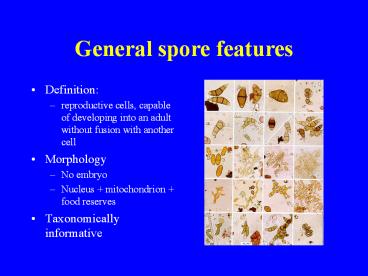General spore features - PowerPoint PPT Presentation
Title:
General spore features
Description:
On average, each individual leaves only a single offspring little investment per ... through an operculum. Mushroom shape contributes to spore release ... – PowerPoint PPT presentation
Number of Views:130
Avg rating:3.0/5.0
Title: General spore features
1
General spore features
- Definition
- reproductive cells, capable of developing into an
adult without fusion with another cell - Morphology
- No embryo
- Nucleus mitochondrion food reserves
- Taxonomically informative
2
Is sporulation effective?
- Species in equilibrium
- On average, each individual leaves only a single
offspring ? little investment per spore - Individual colonies produce massive numbers of
spores - Calvatia 7 trillion spores
- Ganoderma 30 billion spores a day for 5 months
- Aspergillus can produce gt4 billion spores in 3 d
(100mm dish)
3
Spore sizes
- 80 spores are unicellular and lt10µm in their
longest dimension (smallest 2µm) - Largest 100 to 300 µm e. g. Glomus and Gigaspora
- Longest Cordyceps militaris 2 µm x 500 µm asco
4
Spore dispersal passive
- dry conidia -- note must escape still air layer
- aided by cupped structures such as apothecia and
acervuli, which create turbulence - Nik Money has shown that mushroom caps are warm,
presumably generating convection currents
5
Dispersal by water
- spores with slime coat, e.g. Stachybotrys,
Gliocladium ? - spores extruded into slime from deliquescing asci
stinkhorns
6
Dispersal by water
- inky cap mushrooms Coprinus
- Birds nest fungi
- dry conidia -- demo
7
Water dispersal in Nidulariales
8
Dispersal by animals
- includes insects
- sticky spores
- Stachybotrys
- scolytid beetles Ceratocystis
- stinky spores Caninus
- insect feeding on basidiocarps
- fly maggots
- beetles
9
Animal dispersal, continued
- birds
- Cryphonectria parasitica -- 1/3 of trees in
eastern US were sweet chesnut - C. parasitica now used as important commercial
source of rennin - people
- Baker 1966 Inadvertant distribution of fungi Can
J Microbiol 12109-112
10
Active spore dispersal
- requires effort (obvious) so cost/benefit
analysis suggests there should be environmental
sensing so that discharge is optimized
Ascobolus
Sarcoscypha
11
Asci with pore structures
Peziza proteana sparassoides
Rhizocarpon obscuratum
12
Phototropic asci and spore releasethrough an
operculum
13
Mushroom shape contributes to spore release
14
Active support for passive dispersal
15
Bullers drop
www.anbg.gov.au/fungi
16
Convection currents and spore release in mushrooms
- Water evaporation into gill/pore space
- Water condensation onto hilar appendages
- Ballistic launch of spores
Deering et al 2001. Mycologia 93 732-736
17
(No Transcript)
18
Trichoderma sporulation /- light
19
Neurospora photoperiodicity
www.ux.his.no/ruoff/Neurospora_Rhythm.html
20
Neurospora photoperiodicity
www.ux.his.no/ruoff/Neurospora_Rhythm.html
21
Spore discharge in Sordaria- multiple triggers-
heirarchy of effect































